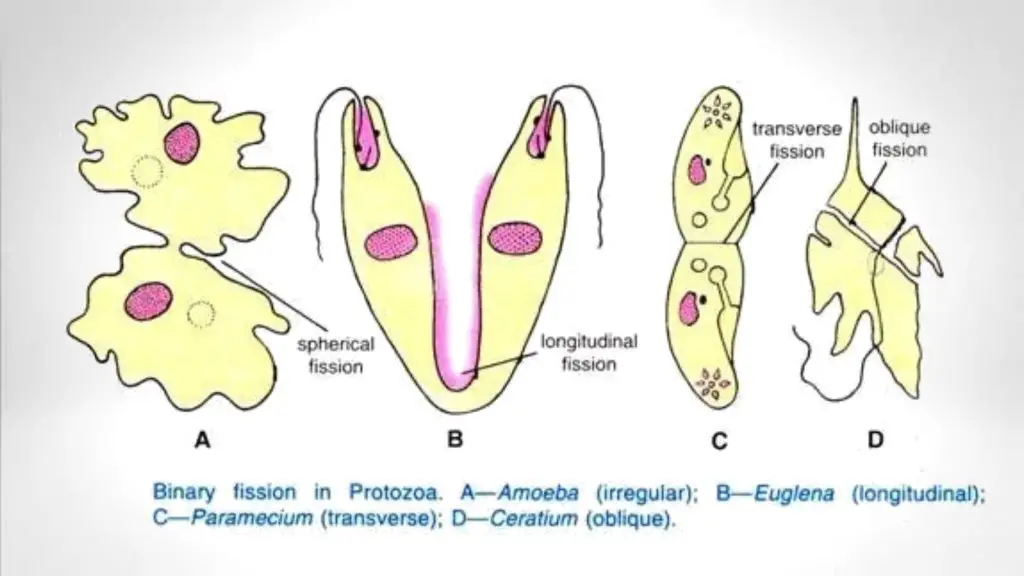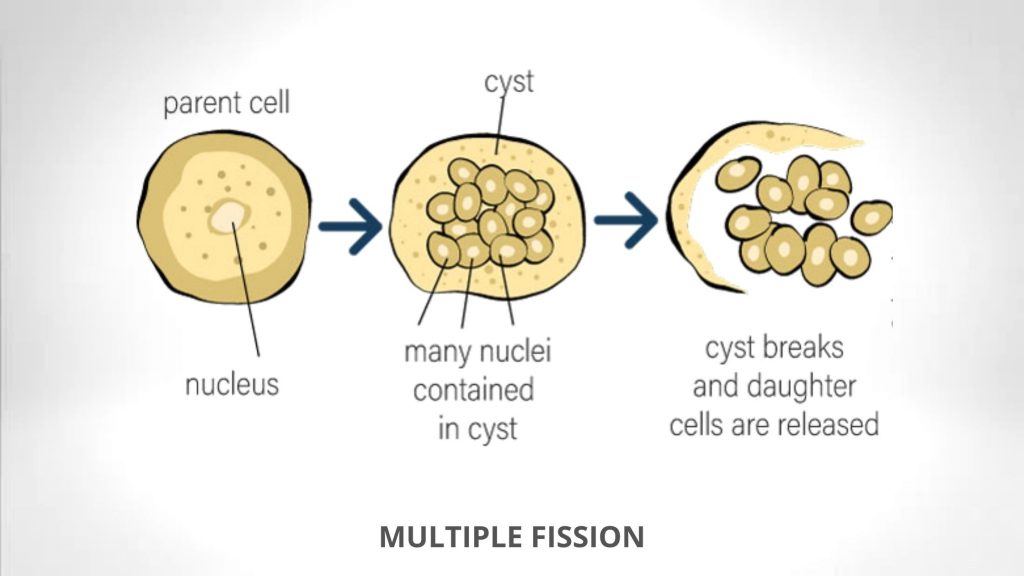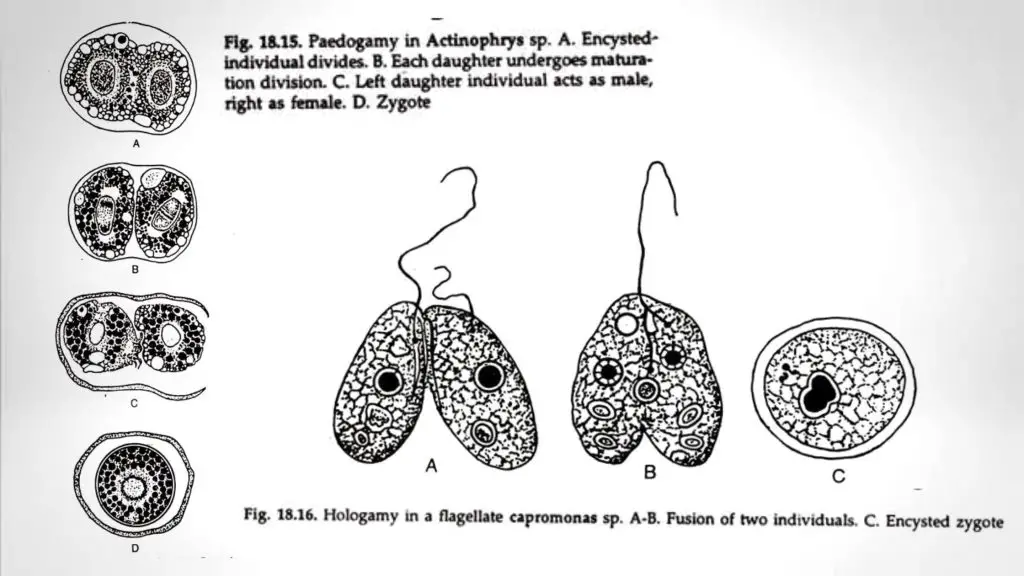Table of Contents
Reproduction in Protozoa
Protozoa carried out their reproduction by asexual and sexual mode of reproduction. The higher group of protozoa follow mainly sexual reproduction. Some protozoa carried out both asexual and sexual reproduction based on the types of the host cells.
There are different modes of reproduction in fungi such as sexual, asexual, and vegetative modes of reproduction….

Asexual Reproduction
The asexual reproduction in protozoa is performed by the formation of the equal or unequal sizes of two daughter cells. During asexual reproduction, protozoa follow different methods such as binary fission, multiple fission, and budding.
If two daughter cells are produced then this process is called binary fission, if more than two daughter cells are produced then the method is termed as multiple fission.
Binary Fission
- This mode of reproduction is mainly found in amoeba. During binary fission, the pseudopodia is withdrawn and then the nucleus started to divides.
- After the completion of nuclear division, the cell started to elongate and constricts in the center to form two daughter cells.
There are different types of binary fission such as;
- Transverse fission. found in Amoeba, Paramoecium, etc.
- Longitudinal fission, found in Euglena, Vorticella, etc.
- Oblique binary fission, found in Dinoflagellata, Ceratium, Cochliodinium, Etc.

Multiple Fission
- In this method, a single mother (parental) cell divides to form many daughter (filial) cells.
- Before the division, multiple nuclei are formed within the mother cell, which then cleaves rapidly to form a corresponding number of daughter cells.
- This type of fission mainly occurs in foraminifera, the radiolaria, and the heliozoa, sporozoa.
Steps of Multiple fission
- In the encysted cell, nucleus started to divides rapidly and produce a large number of daughter nuclei.
- The cytoplasm is fragmented and surrounds each daughter nucleus, thus it forms minute animals.
- In return of favorable conditions, the cyst get bursts and these small animals come out and grow to the adult stage.
Types of Multiple fission
Different types of multiple fission are found in protozoa such as;
- Gamogony, found in Monocytes. In this method product is gamet.
- Scizogony or agamogony occurs in asexual stage, The resulting individuals are known as agametes or merozoites. Example: Plasmodium.
- Sporogony followed by sexual fusion, The products are covered by a cyst or a resistant covering and known as spores. Motile spores are known as swarmer’s or swarmospores. There are two types of swarmers such as Flagellospore, Spores bearing flagella and Pseudopodiospore or amoebospore, Spores beaning pseudopodia.

Plasmotomy
- The cytoplasm of multinucleate individual divides into numerous small multinucleate offspring’s.
- The daughter cells are grown up and the number of nuclei is restored by further nuclear division.
Budding
- The sessile protozoa use the budding process to produce motile offspring. That is, the mother cell remains sessile and releases one or more swarming daughter cells.
- The swarmer varies from the mother cell not only in a lower degree of differentiation but also in the possession of special locomotor organelles.
- The budding process can be two types, exogenous or endogenous. The exogenous budding is observed in suctorians when a portion or portions of an adult sessile suctorian bud from the parent, develop cilia, and swim away.
- While, in endogenous budding, which also occurs in many suctorian species, the swarmer is formed inside the mother cell.
- The budding process is found in Noctiluca, Tokophrya, etc.
Sexual Reproduction in Protozoa
- In sexual reproduction, two gametes unite and forms a new individual. The mating of tow different individual (male and female gametes) is occurred by fusion of their cytoplasm, followed by the union of their nuclei.
- Many protozoa follow sexual reproduction regularly. In this reproduction, meiotic division takes place, which reduces the chromosomes to haploid numbers, occurs mainly before syngamy. This is termed as gametic meiosis, in which gametes become haploid.
- In a few groups of protozoa performs the reduction division after the formation of zygote, this process is known as zygotic meiosis.
- In zygotic meiosis the zygote is diploid but rest of the life cycle is haploid.
- Different Types of Sexual Reproduction occur within Protozoa such as syngamy, conjugation, automyxis.
Syngamy or Sexual Fusion
In this mode of sexual reproduction, two protozoan individuals or gametes permanently fuse and forms a fertilized cell or zygote or oospore. The nucleus of these two individuals also fuse and from the zygote nucleus or synkaryon. Later thus zygote grows into an adult, either directly or by encystment and fission of various types.
Based on the degree of differentiation of the fusing gametes syngamy may be of the following types:
- Autogamy: In this method the gamets of the same parent cell fuse. This method in mainly found in Actinophrys, Actinosphaerium, Paramoecium aurelia, etc.
- Paedogamy: The fusion occurs between two young or new individuals. Example: Actinophrys.
- Hologamy: In this method, fusion occurs between two mature individuals or gamets. Example; Copromonas.
- Merogamy: Mating occurs between two individuals which are smaller than the ordinary vegetative individuals, known as merogametes.
- Isogamy: Fusion occurs between two gametes of similar size and shape. These gamets are mainly developed by multiple or repeated binary fission. Example: found in Foraminifera (Elphidium), Phytomonadina (Chlamydomonas, Copromonas) and Gregarinida (Monocystis).
- Anisogamy: The fusion occurs between two gametes whichdiffer in size, shape and behaviour. This type of gametes are known as heterogametes or anisogametes and their mating process is known as anisogamy or heterogamy. The development of morphologically distinct gametes is the first sign of sex differentiation in Protozoa.
- The smaller gamtes are known as microgametes, or male gametes. These are active, motile, and generally flagellated and more numerous. These are formed by multiple or repeated fissions. The fusion mechanism between two microgametes are known as Micro-gamy. Example: Foraminifera, Arcella, etc.
- The larger gametes are knwon as macrogametes. These are immotile, voluminous, and known as female gametes. The fusion between two macrogametes is known as Macro-gamy. Examples: Plasmodium, Eimeria, Volvox, etc.

Conjugation
- In Conjugation a temporary mating occurs between two mating types of individuals of the same species to perform the transfers of nuclear materials.
- They maintain their distinct individuality and separate out after nuclear exchange.
- These two mating gametes are termed conjugants, they can be either isogamous (Paramecium) or anisogamous (Vorticella).
Automixis
In this method, the fusion occurs between two gametic nuclei which are originated by the division of the single nucleus of an individual. There are different types of Automixis;
- Autogamy: The two mating nuclei come from the same cell like as in Paramecium. All the levels in nuclear changes are alike to conjugation but the fusion take place between the pronuclei of the same individual.
- Paedogamy: In this method, two nuclei of two different parent cells are fused. A single organism encysts and then separates into two or more gametocytes. The nuclei of these gametocytes experience meiosis and the gametes thus generated unite in pairs forming the zygotes. Examples: Actinosphaerium, Actinophrys, myxosporidians, etc.
- Cytogamy: In a number of species of Paramoecium the two individuals fuse with their oral surfaces. The nuclear changes occur as in conjugation but no nuclear exchange occurs. The two gametic nuclei in each individual fuse to form synkaryon. Cytogamy is said to be intermediate between conjugation and autogamy.
- Another types of Automixis is Hemixis.
Other modes of reproduction
- Plasmogamy: In plasmogamy 2 or more mating cells are fused by their cytoplasm to develop a plasmodium and separate out consistent with their distinct nuclei. This method is found in certain Rhizopoda and Mycetozoa.
- Regeneration: The regeneration and replacement of missed sections amongst free-living and few parasitic protists are extensive. A precise relationship of cytoplasm and nucleus can regenerate into an intact individual.
- Parthenogenesis: Parthenogenesis occurs between those gametes which fail to fertilize.Examples: Actinophrys, Chlamydomonas, etc.
